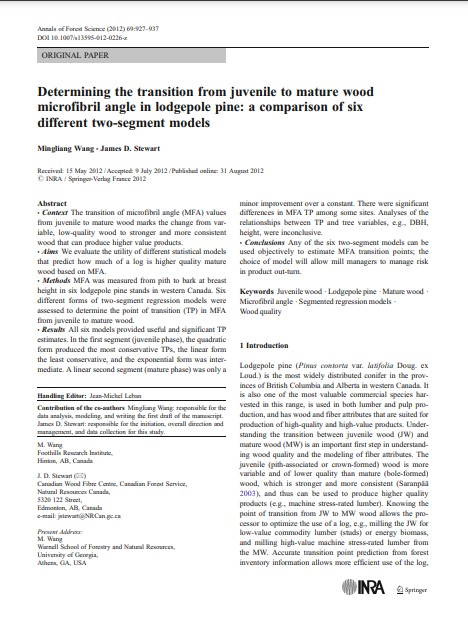Determining the transition from juvenile to mature wood microfibril angle in lodgepole pine: A comparison of six different two-segment models
Bosque Modelo:
Foothills
Temática:
Desarrollo humano
Tipo de documento:
Artículo científico
Resumen
• Context:The transition of microfibril angle (MFA) values from juvenile to mature wood marks the change from variable, low-quality wood to stronger and more consistent wood that can produce higher value products.
• Aims: We evaluate the utility of different statistical models that predict how much of a log is higher quality mature wood based on MFA.
• Methods: MFA was measured from pith to bark at breast height in six lodgepole pine stands in western Canada. Six different forms of two-segment regression models were assessed to determine the point of transition (TP) in MFA from juvenile to mature wood.
• Results: All six models provided useful and significant TP estimates. In the first segment (juvenile phase), the quadratic form produced the most conservative TPs, the linear form the least conservative, and the exponential form was intermediate. A linear second segment (mature phase) was only a minor improvement over a constant. There were significant differences in MFA TP among some sites. Analyses of the relationships between TP and tree variables, e.g., DBH, height, were inconclusive.
• Conclusions: Any of the six two-segment models can be used objectively to estimate MFA transition points; the choice of model will allow mill managers to manage risk in product out-turn.
Información Bibliográfica
Autor:
Wang, M., & Stewart, J.D.
Revista:
Annals of Forest Science
Año:
2012
N°:
-
País :
Canadá
Páginas:
927 - 937
Volumen:
69
Idioma:
Ingles
Palabras claves
uvenile wood Lodgepole pine Mature wood Microfibril angle Segmented regression models Wood quality





